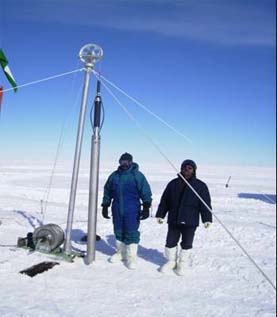
Indian National Report Activities 2006
January 2007
Prepared by: Rasik Ravindra
Indian ice coring program contributes to one of the most significant multi-national scientific initiative by the SCAR (Scientific Committee on Antarctic Research) called ITASE (International Trans Antarctic Scientific Expedition). The first ice core as part of the above project was retrieved near the Humboldt Mountains during the 25th IAE Summer. Since it is essential to have representative ice cores from the coastal region, it was proposed to collect two ice cores from the ice shelf region north of the Schirmacher Oasis.
 Accordingly, a surface convoy was launched from Maitri on 17th Nov 2006 at 09.00 hrs for transferring the drilling equipments, support facilities as well as personnel involved in the drilling operation. The convoy reached the proposed site at 20.30 hrs same day and after a reconnaissance field survey, the drilling site was selected at 70°11'57.4" South Lat and 12°27' 25.1" East Longitude . Three members of the joint NCAOR (National Centre for Antarctic and Ocean Research) –GSI (Geological Survey of India) scientific team (Thamban Meloth, P.K. Shrivastava and P. C. George) and three supporting members from Logistic Team namely E. Cutinha, D. Chakravarthy and Manoj Kumar remained at the drilling site and the remaining logistics team returned after the establishment of the drilling camp.
Accordingly, a surface convoy was launched from Maitri on 17th Nov 2006 at 09.00 hrs for transferring the drilling equipments, support facilities as well as personnel involved in the drilling operation. The convoy reached the proposed site at 20.30 hrs same day and after a reconnaissance field survey, the drilling site was selected at 70°11'57.4" South Lat and 12°27' 25.1" East Longitude . Three members of the joint NCAOR (National Centre for Antarctic and Ocean Research) –GSI (Geological Survey of India) scientific team (Thamban Meloth, P.K. Shrivastava and P. C. George) and three supporting members from Logistic Team namely E. Cutinha, D. Chakravarthy and Manoj Kumar remained at the drilling site and the remaining logistics team returned after the establishment of the drilling camp.
The detailed report on the drilling operation is given below:
- Nov 18th, Establishment of drilling camp; setting up of drilling system and accessories. Started drilling operations. 5.18m ice core raised in the first day of drilling operation. Discussions with the Director, NCAOR, Rasik Ravindra and Arun Chaturvedi, GSI, Faridbad.
- Nov. 19th, Drilling of ice core went up to 17.29 m depth. Snowdrift started. Drilling operation has stopped.
- Nov. 20th, Drilling continued and total recovery of ice core went up to 26.625 m depth.
- Nov. 21st, Drilling of ice core went up to 36.98 m depth.
- Nov. 22nd, Drilling of ice cores reached 38.165 m depth. Heavy snowdrift and strong wind started. Drilling operation had to be stopped.
- Nov. 23rd, Blizzard with wind speed ~80 knot and heavy snowdrift. Visibility less than 10 ft. Literature consultation in the camp.
- Nov. 24th, Blizzard continues with extremely high wind speed and heavy snowdrift, with extremely poor visibility.
- Nov. 25th, Weather improved and the area was cleared and ready for resumption of drilling. Drilling of ice core reached 42.67 m depth.
- Nov. 26th, Recovery of ice cores reached 48.70 m depth.
- Nov. 27th, Drilling reached 52.24 m depth. Local temperature during drilling was -10°C.
- Nov. 28th, Strong wind, about 50 knots, forced the drilling operation to be suspended.
- Nov. 29th, Bad weather continued and forced the team to be restricted to the living accommodation at the site.
- Nov. 30th, Drilling operation resumed after certain changes in the drilling blades. Recovery of ice cores reached 60.54 m depth.
- Dec. 1st, Drilling operation continued and total recovery reached 70.695 m depth. The temperature, during drilling operation has gone down to -12°C.
- Dec. 2nd, Recovery of ice cores reached 74.98 m. Extremely hard and glassy ice, leading sticking of cores to the barrel. Decided to stop the drilling operation at the site.
-
Dec. 3rd, Convoy team reached to drill site for the return journey. All the ice cores were labeled, packed in LDPE rolls and thereafter safely stored in special thermal EPP (Expanded Polypropylene) boxes. These boxes were safely placed in pits below the snow and covered and marked well.
Drilling camp was closed and the machineries were packed properly in the drilling container. Reconnaissance survey made to the south of the drilling site for identifying the second site of drilling operation. - Dec. 4th, Reconnaissance survey continued for the second site for drilling operation. The location has been identified tentatively about 18 Kms southwest of DG point (Location: 70° 13.804’ S and 11° 55.738’ E).
Salient observations:
The first phase of drilling operation in the shelf was very successful with recovery of 75 m long ice core.
Both the scientific and logistic team provided excellent contribution and the team spirit among the members was remarkable.
